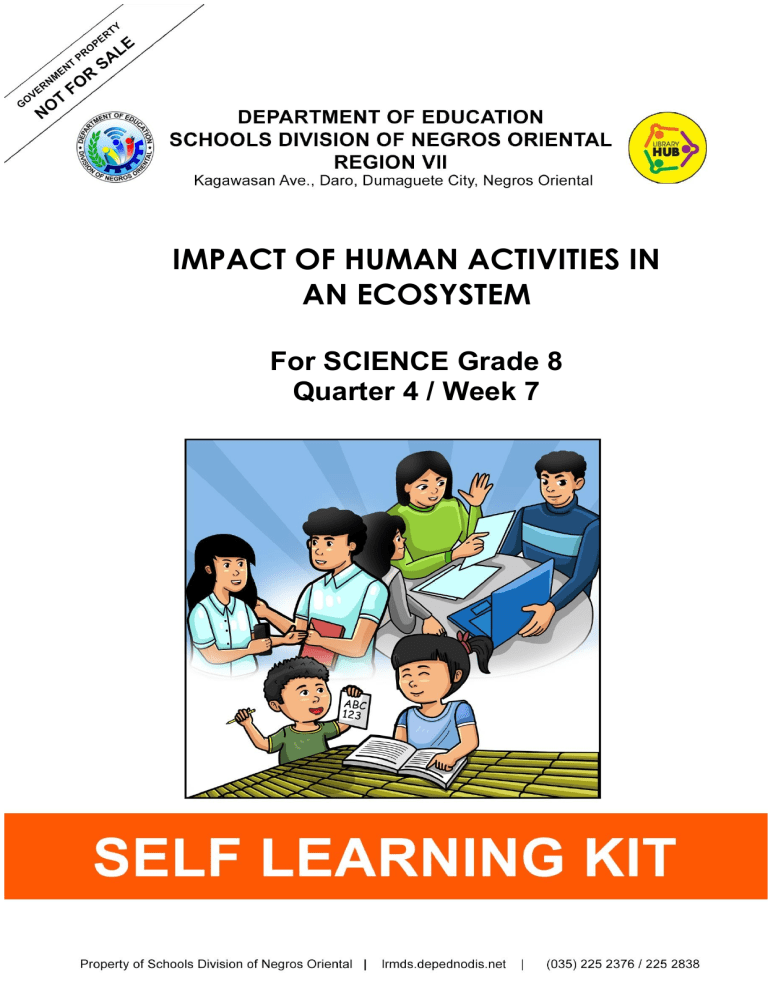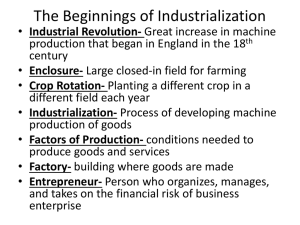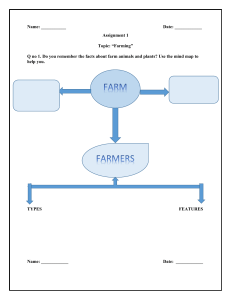
IMPACT OF HUMAN ACTIVITIES IN AN ECOSYSTEM For SCIENCE Grade 8 Quarter 4 / Week 7 1 FOREWORD This self – learning kit will serve as a guide on how to demonstrate an understanding of the oneway flow of energy and the cycling of materials in an ecosystem and identify the different human activities that affect the ecosystem. Students shall be able to enumerate the suggested ways to minimize human impact on the environment. The latter part of this learning material shall allow students to propose a plan on how to help in conserving and protecting the environment. 2 OBJECTIVES: K: S: A: Identify the different human activities that affects the ecosystem Enumerate suggested ways to minimize human impact on the environment Propose a plan on how to help in conserving and protecting the environment. LEARNING COMPETENCY Determine how do human activities affect the Ecosystem and suggest ways to minimize human impact on the environment. (S8LT-IVj-25) I. WHAT HAPPENED dreamstime.com 3 PRE-TEST Modified Multiple Choice DIRECTIONS: Read the following questions and choose the correct answer from the box provided. Write your answers on your notebook/paper. Eutrophication, Monoculture, Insecticide and Pesticide, grazing, Water Pollution, climate change Chemical fertilizer, Deforestation, Plasticulture, Antibiotics __________1. This is the cultivation of a single crop in large areas. Vast tracts of land are converted to rice farms, sugar farms, and coconut farms. __________2. Farmers spray these chemicals to kill insect pests and weeds. __________3. Monocrops usually require large amounts of _____________. Continuous and uncontrolled use of chemical fertilizers may increase soil acidity, thus destroying soil structure. __________4. It is clearing the Earth's forests on a large scale worldwide and resulting in many land damages. One of the causes of deforestation is to clear land for pasture or crops. __________5. Is the use of plastic mulch in agriculture. Farmers use plastic sheets as mulch to cover 50-70% of the soil and allow them to use drip irrigation systems to have better control over soil nutrients and moisture. ___________6. A huge amount of agricultural territory is used primarily as pasture for cattle and other livestock. ___________7. Antimicrobial resistant bacteria can move from farms to humans through food and airborne dust. ___________8. Resulting from conventional agricultural practices is wide-reaching, affecting both surface and groundwater sources, in agricultural communities and those located downstream ___________9. Influences social and environmental determinants of health, including air and water quality and food security. Agriculture and related activities contribute significantly to climate change through greenhouse gas (GHG) emissions. __________10. The gradual increase in the concentration of phosphorus, nitrogen, and other plant nutrients in an aging aquatic ecosystem such as a lake. 4 II. WHAT I NEED TO KNOW DISCUSSION Humans are the top consumers in many food pyramids. To increase food production, they use methods that have an effect on food chains and food webs. Some of the farming practices are described as follows: Monoculture. This is the cultivation of a single crop in large areas. Vast tracts of land are converted to rice farms, sugar farms, and coconut farms. By limiting the cultivation of different kinds of plants, people also deprive many animals of their food and home. These animals, some of which feed on insect pests, move to other places. Only the insect pests that eat the monocrop remain in the area. sustainbiodiversity.weebly.com Herbicides and Insecticides. Farmers spray their crops with insecticides to kill insect pests, and sciencemag.org with herbicides to kill weeds. However, the chemicals also destroy other organisms, including beneficial insects and soil organisms which help in decay. Insecticides move up the food pyramid and accumulate in the body of organisms. The smallest concentration of the chemical is at the base of the pyramid occupied by producers. The amount increases towards the top. The greatest concentration is found in the top consumers such as birds, mammals, and humans. 5 Chemical Fertilizers. Continuous and uncontrolled use of chemical fertilizers may increase soil acidity, thus destroying soil structure. Findings show that more fertilizers are needed for the same amount of yield after years of monoculture. Fertilizers may run off to rivers, ponds, and lakes. Accumulation of fertilizers may cause the death of these bodies of water. Fertilizers in the water will cause increased growth of algae and other water plants. fertilizer-machinery.com Deforestation is clearing the Earth's forests on a large scale worldwide and resulting in many land damages. One of the causes of deforestation is to clear land for pasture or crops. According to British environmentalist Norman Myers, 5% of deforestation is due to cattle ranching, 19% due to over-heavy logging, 22% due to the growing sector of palm oil plantations, and 54% due to slash-and-burn farming. iunc.org Plasticulture is the use of plastic mulch in agriculture. Farmers use plastic sheets as mulch to cover 50-70% of the soil and allow them to use drip irrigation systems to have better control over soil nutrients and moisture. Rain is not required in this system, and farms that use plasticulture are built to encourage the fastest runoff of rain. The use of pesticides with plasticulture allows pesticides to be transported easier in the surface runoff towards wetlands or tidal creeks. 6 canr.msu.edu Livestock Grazing - A huge amount of agricultural territory is used primarily as pasture for cattle and other livestock. In the western United States, counting both federally managed and privately owned grazing lands, hundreds of millions of acres are set aside for this purpose— more than for any other type of land use. Agricultural livestock are responsible for a large proportion of theguiardians.com global greenhouse gas emissions, most notably methane. In addition, overgrazing is a major problem Antibiotics Large-scale use regarding environmental sustainability. of antibiotics in agriculture (for nontherapeutic purposes) compromises drug effectiveness in humans. Antimicrobial resistant bacteria can move from farms to humans through food and airborne dust. These bacteria have also been found in raw and treated drinking water sources, although the presence cannot be directly Fo attributed to agriculture. foodnavigator.com Water pollution resulting from conventional agricultural practices is wide-reaching, affecting both surface and groundwater sources, in agricultural communities and those located downstream. . Water quality standards for agriculturerelated pollution levels include microbial pathogens, nutrient pollution, and pesticides. blog.ipleaders.in 7 Climate change influences social and environmental determinants of health, including air and water quality and food security. Agriculture and related activities contribute significantly to climate change through greenhouse gas (GHG) emissions. The total accumulated emissions associated with agriculture constitutes approximately one-third of GHG emissions worldwide. cocoalife.org onlinesciencenotes.com Eutrophication, the gradual increase in the concentration of phosphorus, nitrogen, and other plant nutrients in an aging aquatic ecosystem such as a lake. The productivity or fertility of such an ecosystem naturally increases as the amount of organic material that can be broken down into nutrients increases. This material enters the ecosystem primarily by runoff from land that carries debris and products of the reproduction and death of terrestrial organisms. Whalecoastconservation.org 8 Top 5 sustainable and eco-friendly farming practices With the rising awareness about the environmental harm caused by large-scale agriculture, eco-friendly farming has become a priority. The solution which can offset damages such as forest clearings, destruction of habitats, the negative impact of pesticides and intense carbon outputs is sustainable farming. Both policymakers and environmentalists are actively promoting eco-friendly and sustainable farming solutions to overcome these damages. Here are the top 5 sustainable farming practices which guarantee a green and environmentally friendly growth of vegetables and plants. 1.Permaculture is a food production system which mimics how vegetables and plants grow in natural ecosystems. It applies natural principles which combine intention, smart farming and design to reduce waste of resources and increase production efficiency. The design techniques in permaculture include growing grains and vegetables without tillage, each plant undertaking various purposes, herb and plant spirals, hügelkultur beds and developing swales to hold water. motherearthnews.com 2. Aquaponics & Hydroponics are innovative farming methods which involve soilless plant and vegetable growth, feeding the plants with nutrients which are carried by the water. Hydroponics systems involve using mineral solutions to feed the plants' roots directly in a passive medium such as perlite or gravel. However, aquaponics farming systems combine aquaculture and hydroponics elements. Water which contains nutrients resulted from the mineralization of fish waste feeds the roots of plants and vegetables which can grow in various mediums. The water is purified by the plants and returns to the hydroponics section of the system. 9 Freshwater.com 3. Using Renewable Energy Resources Sustainable farming involves the use of alternative energy sources such as hydropower, solar power or wind farms which are eco-friendly. Solar panels can be used to run pumping and heating systems. Also, hydroelectric power sourced from river water can be used for various farming machinery. Farmers can compare energy consumption rates by using an online energy compare site to identify the best suitable power sources. countrysideonline.co.uk 10 4. Crop Rotation & Polycultures Farmers can decrease the chances of plant and vegetable diseases through crop diversification on a surface of land and through crop rotation techniques. The practices can also reduce the amount of pesticides and chemical fertilizers required alamy.com 5. Trees Can Increase Crop Yields Agroforestry is a farming method which involves growing shrubs and trees among other plants and vegetables. It combines forestry and agricultural practices to guarantee a sustainable and highly productive approach to land use. The system mimics forest ecosystems found in nature and it's designed to comprise multiple layers of food forests. It includes perennial plants such as fruit trees, perennial herbs, mushrooms, and other vegetables on the ground level and underground root vegetables. Compared to traditional farming systems, agroforestry can double crop yields and significantly decreases the need for chemical fertilizers or pesticide. Just like below, agroforestry in rice production. fao.org 11 III. WHAT HAVE I LEARNED POST-TEST Multiple choice: Choose the letter of the best answer. Write your answers in your notebook/paper. 1. This is the cultivation of a single crop in large areas. Vast tracts of land are converted to rice farms, sugar farms, and coconut farms. a. Water pollution b. Monoculture c. insecticide d. antibiotics 2. Farmers spray these chemicals to kill insect pests and weeds. a. Water pollution b. Monoculture c. insecticide d. antibiotics 3. Continuous and uncontrolled use of ______________ may increase soil acidity, thus destroying soil structure. a. Water pollution b. Chemical fertilizer c. insecticide d. antibiotics 4. It is clearing the Earth's forests on a large scale worldwide and resulting in many land damages. One of the causes of deforestation is to clear land for pasture or crops. a. Deforestation b. Chemical fertilizer c. insecticide d. antibiotics 5. Is the use of plastic mulch in agriculture. Farmers use plastic sheets as mulch to cover 50-70% of the soil and allow them to use drip irrigation systems to have better control over soil nutrients and moisture. a. Deforestation b. chemical fertilizer c. plasticulture d. Antibiotics 6. A huge amount of agricultural territory is used primarily as pasture for cattle and other livestock. a. Grazing b. deforestation c. pesticide d. antibiotics 7. Antimicrobial resistant bacteria can move from farms to humans through food and airborne dust. a. Grazing b. deforestation c. pesticide d. antibiotics 8. Resulting from conventional agricultural practices is wide-reaching, affecting both surface and groundwater sources, in agricultural communities and those located downstream. a. Water pollution b. Monoculture c. insecticide d. antibiotics 9. Influences social and environmental determinants of health, including air and water quality and food security. Agriculture and related activities contribute significantly to climate change through greenhouse gas (GHG) emissions. a. Water pollution b. Monoculture c. climate change d. antibiotics 10. The gradual increase in the concentration of phosphorus, nitrogen, and other plant nutrients in an aging aquatic ecosystem such as a lake. a. Water pollution b. Monoculture c. climate change d. eutrophication 11. Farmers can decrease the chances of plant and vegetable diseases through crop diversification on a surface of land and through crop rotation techniques. a. crop rotation b. agroforestry c. using renewable energy resources d. hydrophonics 12 12. Sustainable farming involves the use of alternative energy sources such as hydropower, solar power or wind farms which are eco-friendly. a. crop rotation b. agroforestry c. using renewable energy resources d. hydrophonics 13. A farming method which involves growing shrubs and trees among other plants and vegetables. a. crop rotation b. agroforestry c. using renewable energy resources d. hydrophonics 14. Is a food production system which mimics how vegetables and plants grow in natural ecosystems. a. permaculture b. agroforestry c. hydroponics d. crop rotation 15. Are innovative farming methods which involve soilless plant and vegetable growth, feeding the plants with nutrients which are carried by the water. a. permaculture b. agroforestry c. hydroponics d. crop rotation 13 REFERENCES: Books: Department of Education (2013) Science - Grade 8 Learner’s Module First Edition, 2nd Floor Dorm G, Philsports Complex Meralco Avenue, Pasig City, Philippines. 1600 Vibal Publishing House (2003) Science and Technology Series, Functional Biology, Modular Approach. Vibal Publishing House, 1253, G. Araneta Ave., Quezon City Websites alamy.com blog.ipleaders.in canr.msu.edu cocoalife.org countrysideonline.co.uk dreamstime.com fao.com fertilizer-machinery.com foodnavigator.com Freshwater.com hortidaily.com iunc.org motherearthnews.com 14 DEPARTMENT OF EDUCATION SCHOOLS DIVISION OF NEGROS ORIENTAL SENEN PRISCILLO P. PAULIN, CESO V Schools Division Superintendent FAY C. LUAREZ, TM, Ed.D., Ph.D. OIC - Assistant Schools Division Superintendent Acting CID Chief NILITA L. RAGAY, Ed.D. OIC - Assistant Schools Division Superintendent ROSELA R. ABIERA Education Program Supervisor – (LRMS) ARNOLD R. JUNGCO PSDS - Division Science Coordinator MARICEL S. RASID Librarian II (LRMDS) ELMAR L. CABRERA PDO II (LRMDS) JUSTIN PAUL ARSENIO C. KINAMOT Writer KEENJI L. ARMENTANO Layout Artist _________________________________ ALPHA QA TEAM MA. ALETTA AARONA R. GAJELOMO JUSTIN PAUL ARSENIO C. KINAMOT MIEL C. PACULANANG PETER PAUL A. PATRON LYN-NO A. REGALADO BETA QA TEAM LIEZEL A. AGOR JOAN Y. BUBULI LIELIN A. DE LA CERNA PETER PAUL A. PATRON THOMAS JOGIE U. TOLEDO DISCLAIMER The information, activities and assessments used in this material are designed to provide accessible learning modality to the teachers and learners of the Division of Negros Oriental. The contents of this module are carefully researched, chosen, and evaluated to comply with the set learning competencies. The writers and evaluator were clearly instructed to give credits to information and illustrations used to substantiate this material. All content is subject to copyright and may not be reproduced in any form without expressed written consent from the division. 15 SYNOPSIS ANSWER KEY This student learning kit deals the categories of the one-way flow of energy and the cycling of materials in an ecosystem. This learning kit identifies the different human activities that affects the ecosystem. This kit enumerates the suggested ways to minimize human impact on the environment. Propose a plan on how to help in conserving and protecting the environment. This lesson is in line with the latest Most Essential Learning Competency prepared by our department for this pandemic. AUTHOR Author: JUSTIN PAUL ARSENIO C.KINAMOT, MAEd Gen. Sci. A graduate of Bachelor in Secondary Education major in General Science from St. Paul University Dumaguete in 2004. He has finished his Graduate Studies from Foundation University with the degree Master of Arts in Education Major in General Science in 2014 and has recently Completed his Academic Requirement of Doctor of Education major in Science Education at Negros Oriental State University.. A consistent writer for Unified Lesson Plans and Modules in Science for the Department of Education, Division of Negros Oriental and the current focal person for Biology Subject. A teacher III, presently connected at Crisostomo O. Retes National High School having an advisory in Grade 8. 16





